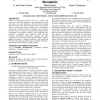Free Online Productivity Tools
i2Speak
i2Symbol
i2OCR
iTex2Img
iWeb2Print
iWeb2Shot
i2Type
iPdf2Split
iPdf2Merge
i2Bopomofo
i2Arabic
i2Style
i2Image
i2PDF
iLatex2Rtf
Sci2ools
ATAL
2010
Springer
2010
Springer
Agent interaction, multiple perspectives, and swarming simulation
Agents in a multi-agent system do not act in a vacuum. The outcome of their efforts depends on the environment in which they seek to act, and in particular on the efforts of other agents with whom they share the environment. We review previous efforts to address this problem, including active environments, concurrency modeling, recursive reasoning, and stochastic processes. Then we propose an approach that combines active environments and stochastic processes while addressing their limitations: a swarming agent simulation (which maintains transition probabilities dynamically, avoiding the static assumptions most convenient with traditional Markov models), applied concurrently to multiple perspectives (thus partitioning the active environment and addressing its scalability challenges). We demonstrate this method on a simple example. Categories and Subject Descriptors I.2.11 [Computing Methodologies]: Distributed Artificial Intelligence
Active Environment | ATAL 2010 | Intelligent Agents | Stochastic Processes | Swarming Agent Simulation |
Related Content
| Added | 08 Nov 2010 |
| Updated | 08 Nov 2010 |
| Type | Conference |
| Year | 2010 |
| Where | ATAL |
| Authors | H. Van Dyke Parunak, Robert Bisson, Sven A. Brueckner |
Comments (0)

